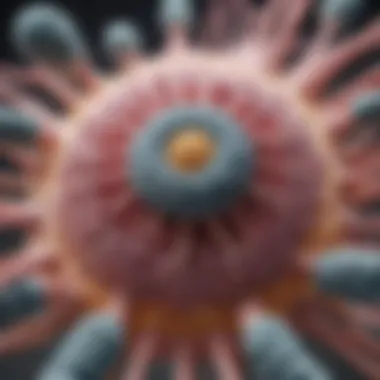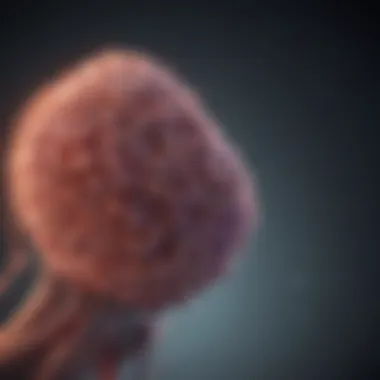Exploring Advances in Small Cell Lung Cancer Treatment


Intro
Small cell lung cancer (SCLC) is a complex and aggressive form of lung cancer that poses significant challenges in both diagnosis and treatment. This article aims to provide a comprehensive overview of the current landscape of SCLC medicine, focusing on diagnostic methodologies, treatment options, and emerging research endeavors. By dissecting both the biochemical mechanisms underlying SCLC and the evolving therapeutic avenues, this guide is designed to inform students, researchers, clinicians, and patients alike.
A deeper understanding of SCLC's pathogenesis is imperative, as it can lead to more effective management strategies. The rapid evolution of this field calls for ongoing investigation into novel therapies that might improve survival rates for patients afflicted by this condition. Therefore, this article not only encapsulates what is known but also highlights where we as a scientific community should direct our future efforts to combat this formidable disease.
Methodology
Overview of Research Methods Used
Research on small cell lung cancer utilizes a blend of quantitative and qualitative methods to offer insight into various aspects of the disease. An essential part of this methodology includes clinical trials that evaluate new treatment options, as well as retrospective studies that analyze existing patient data to elucidate treatment outcomes.
A systematic review is conducted to gather data from diverse studies, providing a robust synthesis of findings related to SCLC. This multifaceted approach allows for a broader understanding of the effectiveness of different treatment modalities, as well as their impact on patients’ quality of life.
Data Collection Techniques
Data collection in this field is meticulous due to the intricacies of cancer research. Various techniques are employed, including:
- Clinical Trials: These are structured studies that involve patient participation, enabling the evaluation of new drugs like etoposide and carboplatin.
- Biomarker Analysis: Gathering samples for analysis allows researchers to identify specific biomarkers associated with SCLC progression.
- Patient Registries: Long-term collections of patient data provide valuable insights into treatment effectiveness over time.
- Surveys and Questionnaires: These tools gather subjective data regarding patient experiences and outcomes.
"Understanding the data from multiple sources is crucial in developing comprehensive treatment strategies for small cell lung cancer."
Future Directions
Upcoming Trends in Research
Current research is pointing towards several promising trends in the management of SCLC. Personalized medicine, which tailors treatment based on individual patient characteristics, is gaining traction. Immunotherapy, for instance, is increasingly being evaluated as a potential option for managing SCLC. Therapies targeting specific genetic mutations related to tumor growth are also under exploration.
Areas Requiring Further Investigation
Despite advancements, numerous gaps remain. Significant areas needing investigation include:
- The role of the tumor microenvironment in SCLC progression and treatment response.
- Developing effective combination therapies that optimize patient outcomes.
- Addressing treatment-induced side effects and understanding long-term survivorship.
In summary, while there is progress being made in SCLC medicine, challenges persist. Continued research and innovation will be pivotal in the ongoing battle against this aggressive cancer type. By thoroughly investigating the complexities and nuances of SCLC, the health community can better advocate for patients and work toward improved therapeutic options.
Intro to Small Cell Lung Cancer
Understanding small cell lung cancer (SCLC) is crucial due to its aggressive nature and unique treatment necessities. In this section, we will delve into the particular characteristics of SCLC, how it differs from non-small cell lung cancer, and why this distinction matters in medical practice. This cancer type is known for its rapid growth and early metastasis, leading to poorer prognoses compared to other forms of lung cancer.
SCLC accounts for approximately 15% of all lung cancer cases. Recognizing its symptoms early can be lifesaving, emphasizing the importance of awareness among both patients and healthcare providers. Additionally, SCLC's response to treatment varies significantly; thus, understanding this aspect allows for better management strategies moving forward.
Understanding SCLC
SCLC is a highly malignant neoplasm that primarily originates from neuroendocrine cells in the lung's large airways. It is usually diagnosed at a more advanced stage, which complicates treatment options. SCLC is classified into two main stages: limited and extensive disease. In limited SCLC, the cancer is confined to one side of the chest and can potentially be treated with curative intent. However, in extensive SCLC, the cancer has spread beyond the original site, indicating a more challenging prognosis and treatment approach.
The hallmark of SCLC is the small, oval-shaped cells which grow in clusters. The rapid proliferation and the appearance of the cells under a microscope distinguish them from other lung cancer types. This type of cancer is also associated with paraneoplastic syndromes, presenting unique symptoms that may not be directly related to lung function.
Epidemiology and Risk Factors
Several risk factors contribute to the development of SCLC. Smoking remains the most significant factor, with nearly 90% of SCLC cases linked to tobacco use. Exposure to secondhand smoke can also play a role. Besides smoking, other risk factors include:
- Occupational exposure: Specific jobs may expose individuals to harmful substances like asbestos or certain chemicals.
- Radiation: Previous radiation therapy to the chest can increase risk.
- Genetic predisposition: Family history of lung cancer may indicate a hereditary risk.
The epidemiology of SCLC reflects a predominance in older adults, typically affecting individuals aged 60 and above. While it can occur in younger individuals, it is rare.


Key takeaway: Awareness of SCLC’s unique characteristics, epidemiology, and risk factors is critical for early detection and effective management.
Biology of SCLC
Understanding the biology of small cell lung cancer (SCLC) is crucial for various aspects of medical research and treatment. This section elucidates the fundamental cellular and molecular characteristics of SCLC. Such insights help in identifying unique treatment targets and improving diagnostic approaches. Grasping these biological perspectives can lead to enhanced patient care and more effective treatment strategies.
Cellular Characteristics of SCLC
Small cell lung cancer is distinguished by its rapid growth and aggressive nature. The cells in SCLC are typically small, round, and have scant cytoplasm. This gives them a dense morphology under the microscope. The high mitotic index indicates a high rate of cell division, resulting in quick tumor progression. SCLC often presents as a solid tumor, primarily in the central airways of the lungs.
Several specific features characterize SCLC cells:
- Neuroendocrine Differentiation: SCLC is classified as a neuroendocrine tumor. The presence of neurosecretory granules is common, which indicates the secretion of bioactive substances.
- High Growth Fraction: These cancers usually have a high growth fraction. This means that a large proportion of cancer cells are actively dividing.
- Resistance to Apoptosis: SCLC cells often exhibit a resistance against programmed cell death, or apoptosis. This contributes to their survival and the difficulty in treating this cancer effectively.
In terms of histopathological features, SCLC shows marked nuclear atypia and pleomorphism, another sign of aggressive behavior. As a whole, understanding these characteristics is key when developing targeted therapies.
Molecular Pathogenesis
The molecular mechanisms driving SCLC are complex and involve numerous genetic and epigenetic alterations. A significant aspect of SCLC biology is its relationship with well-known carcinogens, especially tobacco smoke. Exposure to these carcinogens leads to mutations in critical genes. The most notable alterations in SCLC often occur in the following genes:
- TP53: Mutations in the TP53 tumor suppressor gene are common. This gene plays a pivotal role in controlling the cell cycle and preventing tumor formation.
- RB1: The RB1 gene, involved in cell cycle regulation, is frequently inactivated. Loss of RB1 function facilitates uncontrolled cellular proliferation.
- MYC: Overexpression of MYC and other oncogenes has been observed in SCLC patients. These genes promote cell growth and cause malignant transformation.
The interplay between these genetic factors and the tumor microenvironment shapes the pathogenesis of SCLC. Insights into these molecular pathways pave the way for targeted therapy development, providing potential avenues for more effective treatment regimes.
"Understanding the biology of SCLC cannot just enhance therapeutic strategies, but can ideally lead to better patient prognosis."
Research continues to provide a better understanding of how these altered molecular pathways contribute to the aggressive nature of small cell lung cancer. Future studies are likely to further dissect these pathways and explore novel therapeutic interventions.
Diagnosis of SCLC
The diagnosis of small cell lung cancer (SCLC) is a critical subject in understanding this aggressive malignancy. An accurate diagnosis directly influences treatment choices and prognosis. Timely and effective diagnosis can lead to improved outcomes for patients. Physicians employ a blend of clinical evaluation, imaging studies, and histopathological assessments to arrive at a comprehensive diagnosis. This diagnosis journey is complex, necessitating a thorough approach to identify the specific characteristics of SCLC.
Clinical Presentation and Initial Evaluation
The initial clinical presentation of SCLC can be subtle and often overlaps with other respiratory conditions. Common symptoms include persistent cough, chest pain, and weight loss. Some patients may also experience hoarseness or dysphagia. A meticulous patient history and physical examination are essential. This evaluation assists in identifying risk factors like smoking history, which is relevant given that the vast majority of SCLC cases arise in smokers.
Initial evaluation often includes a review of symptoms and a detailed physical assessment. Physicians may also conduct blood tests and pulmonary function tests to gather more information. The challenges lie in recognizing the symptoms early, as they can easily be dismissed as indications of benign respiratory issues.
Imaging Techniques
Imaging plays a vital role in diagnosing SCLC. Common techniques employed include chest X-rays and computed tomography (CT) scans.
- Chest X-ray: This is often the first step in imaging, but it may not always reveal the presence of SCLC in early stages.
- CT scan: A CT scan provides detailed images of the lungs and is more sensitive in detecting tumors and assessing their extent. It is crucial for staging the cancer and planning treatment.
Advanced imaging modalities, such as positron emission tomography (PET) scans, may also be utilized to evaluate dissiminated disease. These scans help in determining whether cancer has spread to lymph nodes or other organs. The choice of imaging technique is determined by the clinical scenario and the information required to formulate a diagnostic impression.
Histopathological Assessment
Histopathological assessment is necessary to confirm the diagnosis of SCLC. This process typically involves obtaining a tissue sample through procedures such as bronchoscopy or fine-needle aspiration. The collected samples are then examined microscopically to identify cancerous cells.
The histopathological evaluation focuses on the cell morphology and specific markers characteristic of SCLC, such as neuroendocrine marker expression. This assessment provides not only confirmation of the diagnosis but also insight into the tumor's aggressiveness.
Treatment Strategies
Treatment strategies for small cell lung cancer (SCLC) are essential due to the aggressive nature of this disease. Effective management can significantly influence patients’ survival and quality of life. Treatment usually involves a multi-modal approach, integrating chemotherapy, radiation therapy, surgical interventions, and newer immunotherapy protocols. Each of these methods has unique benefits and considerations, tailored to the stage of cancer, patient's health, and specific tumor characteristics.
Chemotherapy Protocols


Chemotherapy remains the cornerstone of SCLC treatment. The typical regimen involves a combination of drugs, primarily platinum-based agents like cisplatin or carboplatin, along with etoposide. These agents work synergistically to disrupt the cancer cells’ ability to divide and multiply.
The choice of chemotherapy regimen can depend on several factors, including the performance status of the patient and the extent of the disease. Initial treatments aim to reduce tumor burden and manage symptoms. Notably, patients with extensive-stage SCLC often receive concurrent chemoradiation to maximize treatment effectiveness.
Chemotherapy not only targets the primary tumor but also addresses micrometastatic disease that may not be detected through imaging.
Despite its effectiveness, chemotherapy can lead to side effects such as nausea, fatigue, and immune suppression. Managing these side effects is crucial to maintain the treatment quality and ensure patients can continue their therapy.
Radiation Therapy
Radiation therapy is another vital component in treating SCLC, particularly when combined with chemotherapy. It is often used in two main contexts: as prophylactic cranial irradiation (PCI) and in conjunction with local treatment for patients with limited-stage disease.
The rationale behind PCI is to reduce the risk of brain metastases, which are common in SCLC patients. Administering radiation to the brain after initial treatment can significantly improve overall survival rates.
In cases where cancer is localized, targeted radiation can shrink tumors and alleviate symptoms. Advances in techniques such as stereotactic body radiotherapy (SBRT) have improved outcomes and reduced damage to surrounding healthy tissue.
Surgical Interventions
Surgery is less common in the management of SCLC, given its rapid progression and tendency to metastasize. However, for patients with limited-stage disease, surgical resection may be appropriate. Surgical options can include lobectomy or pneumonectomy, depending on the tumor's size and location.
Typically, surgery is performed after complete or near-complete response to chemotherapy to ensure maximal tumor removal. Surgical interventions might help eliminate the cancer and reduce recurrence rates. Nevertheless, careful evaluation of the risks and benefits is necessary, considering the patient's overall health and prognosis.
Immunotherapy in SCLC
Recent advancements in cancer research have brought immunotherapy to the forefront of SCLC treatment. Drugs like atezolizumab and durvalumab, which target the programmed cell death protein 1 (PD-1) and programmed death-ligand 1 (PD-L1) pathways, are being explored to enhance immune response against SCLC cells.
These therapies can be used in combination with chemotherapy, providing an additional avenue for managing advanced disease. Immunotherapy has shown promising results in improving survival rates and can offer a better quality of life for many patients. However, the efficacy may vary from person to person, and researchers are still investigating biomarkers to predict which patients are likely to benefit the most.
Emerging Therapies and Research Directions
Emerging therapies and research directions represent a vital area in the study and treatment of small cell lung cancer (SCLC). This subfield aims to explore novel methodologies that can augment existing treatment protocols. With the inherent aggressiveness of SCLC, innovative approaches can greatly change patient outcomes. Research into these therapies is critical as we seek to understand their roles in improving efficacy and minimizing side effects in SCLC management.
Targeted Therapies
Targeted therapies focus on specific genetic markers and molecular pathways associated with SCLC. These drugs aim to disrupt the cancer growth process at a cellular level, potentially reducing harm to surrounding healthy tissues. Research indicates that certain patients may benefit from therapies targeting specific mutations or overexpressed proteins in their tumors.
For instance, inhibitors like Lurbinectedin have shown promise in recent studies. They work by binding to DNA, thereby hindering the cancer cell's ability to replicate and grow. Identifying which patients are more likely to respond to these treatments remains essential in enhancing treatment success.
Role of Personalized Medicine
Personalized medicine tailors treatment plans to fit the individual characteristics of each patient's cancer. In SCLC, this approach is gaining traction due to the heterogeneity in tumors. Understanding the specific profile of a patient's cancer can guide the selection of therapies that are more likely to be effective.
Advancements in genomics and proteomics play a pivotal role in personalized medicine. Tests that analyze tumor DNA can inform clinicians about the most suitable treatment options. For example, using biomarker assessments can help determine if a patient is likely to respond to immunotherapy or targeted therapy, making it possible to customize care effectively.
Future Clinical Trials
Future clinical trials are crucial in shaping the landscape of SCLC treatment. These trials not only test the efficacy of emerging therapies but also explore combinations of existing treatments to determine if they can achieve better outcomes. Ongoing trials may focus on various aspects, such as combining chemotherapy with newer immunotherapy agents, which may help improve long-term survival rates.
Participation in clinical trials not only offers patients access to cutting-edge treatment options but also contributes to the broader understanding of SCLC. Each trial adds valuable data to the body of knowledge, potentially leading to breakthroughs in therapy.
Clinical trials are integral for advancing medical knowledge and developing new therapies, as they provide crucial insights into treatment efficacy and safety.
Managing Side Effects and Palliative Care
Managing side effects and providing palliative care are essential components in the treatment plan for small cell lung cancer (SCLC). Patients often endure various symptoms and complications due to aggressive therapies, including chemotherapy, radiation, and immunotherapy. Understanding these side effects helps predict, prevent, and alleviate discomfort, thereby improving the patient’s overall experience and quality of life.
Palliative care goes beyond symptom management; it focuses on providing holistic support. This type of care addresses not just physical symptoms but also emotional and psychological distress. It enhances the patient’s ability to cope with their condition and engages the family in the care process. This integration of physical and emotional care is especially critical in a challenging illness like SCLC.


Common Side Effects of Treatment
Patients receiving treatment for SCLC face numerous common side effects that can significantly impact their day-to-day lives:
- Nausea and Vomiting: These reactions are particularly prevalent following chemotherapy cycles. Antiemetic medications can alleviate these symptoms, but some individuals may still feel discomfort.
- Fatigue: Extreme tiredness is often reported by patients during and after treatment, affecting their ability to perform daily activities.
- Hair Loss: Many patients experience alopecia, which can affect self-esteem and emotional well-being.
- Mouth Sores: Chemotherapy can cause mucositis, leading to painful sores, thus complicating eating and drinking.
- Changes in Appetite: Treatments may alter taste and smell, leading to general loss of interest in food. This can have downstream effects, affecting nutritional intake and overall health.
- Cognitive Effects: Sometimes referred to as "chemo brain", this condition can include difficulties with memory, concentration, and processing information.
It is crucial for both patients and healthcare professionals to be aware of these potential side effects. Open communication can facilitate timely interventions, improving the overall management of symptoms.
"Palliative care is not about giving up; it is about ensuring the best possible quality of life while managing side effects of treatment."
Palliative Care Approaches
Palliative care approaches provide a framework for managing the myriad of challenges faced by SCLC patients. Effective strategies include:
- Symptom Management: Tailored interventions are applied based on individual patient needs. Medications, dietary modifications, and techniques such as acupuncture may alleviate specific symptoms.
- Psychological Support: Psychological counseling can support patients facing existential concerns. This includes addressing anxiety and depression, often heightened by a cancer diagnosis.
- Family Involvement: Involving family members in care planning helps create a supportive environment and addresses the needs of caregivers.
- Pain Management: Utilizing analgesics or palliative care specialists can help minimize discomfort resulting from both the cancer and its treatment.
- Coordination of Care: Interdisciplinary teams work together to ensure comprehensive care, aiding in the navigation of medical systems, which can be overwhelming.
When these palliative care approaches are integrated into the treatment plan, they work synergistically alongside curative measures to enhance the patient’s overall well-being. It is essential to view palliative care not as an endpoint, but as a companion to therapeutic interventions that acknowledge the complexity of living with small cell lung cancer.
Quality of Life Considerations
Quality of life in patients with small cell lung cancer (SCLC) is a crucial topic that often gets overshadowed by clinical outcomes and survival rates. Understanding the dimensions of quality of life is necessary for comprehensive cancer care. It is especially important for patients as they undergo various treatments and face numerous challenges. As such, this section will focus on the psychosocial impacts and support systems that can facilitate better living conditions for these patients.
Psychosocial Impacts
SCLC is not merely a medical diagnosis; it transforms the patient's life in profound ways. The first impact is emotional. Patients often experience anxiety and depression due to the severity of the disease. They worry about their prognosis, treatment side effects, and the future. Counseling can help, but access to mental health resources is often limited.
Social relationships are also affected. Patients may feel isolated. Friends and family members might not fully understand the disease or its impacts. This can lead to a sense of loneliness, which further exacerbates emotional distress. Some patients withdraw from social activities, feeling that they are a burden to others.
Specific psychological challenges for SCLC patients include:
- Fear of disease progression
- Feelings of powerlessness
- Coping with changes in body image due to treatment
- Anxiety about financial burdens related to illness
In addressing these issues, healthcare professionals should promote mental health support. Integrating psychological assessment into regular treatment plans can beneficial.
Support Systems for Patients
Support systems are vital for enhancing the quality of life of patients battling SCLC. These systems can take many forms, including emotional support, informational resources, and practical assistance.
- Family and Friends: They often provide immediate emotional support. Encouraging open dialogues about fears and concerns can strengthen these bonds.
- Support Groups: Joining a support group allows patients to connect with others in similar situations. Group members share experiences, coping strategies, and encouragement.
- Healthcare Providers: A compassionate treatment team can make a significant difference. Nurses, social workers, and psychologists can offer crucial support services alongside medical care.
- Online Resources: Websites like Reddit and specialized forums provide platforms for sharing experiences and gaining insights into managing the disease. Connecting with communities offers a sense of belonging.
- Financial Assistance Programs: Many organizations offer financial guidance for patients facing economic strain. Knowing that help is available can reduce stress.
"Quality of life is not just about surviving; it's about thriving during and after treatment."
In sum, enhancing quality of life for SCLC patients requires a multi-faceted approach. By recognizing the psychosocial impacts and providing effective support systems, healthcare providers can facilitate better patient experiences during this difficult journey. Engaging all stakeholders—patients, family, friends, and health professionals—creates an environment conducive to coping and resilience.
Finale
The conclusion is a pivotal part of any article, and in this instance, it summarizes the complex nature of small cell lung cancer (SCLC) medicine. The findings presented throughout this article illuminate the aggressive characteristics of SCLC and the multifaceted approaches required for diagnosis and treatment. The insights garnered reinforce the notion that understanding this cancer type is essential for effective management.
Summary of Key Findings
Throughout the discussion, several key findings emerge.
- Nature of SCLC: Small cell lung cancer stands out due to its rapid proliferation and propensity for early metastasis.
- Diagnosis: Effective diagnostic methods are crucial. Clinical presentation, imaging techniques, and histopathological assessments hold significant weight in the early detection and treatment planning.
- Treatment Landscape: A range of treatment modalities exists for SCLC. Chemotherapy remains a cornerstone, while radiation therapy and immunotherapy are gaining traction as adjunct treatments.
- Emerging Therapies: Encouraging trends in research show promise for targeted therapies and personalized medicine approaches, which may address individual patient needs better.
- Quality of Life: Managing side effects and ensuring psychosocial well-being is equally important.
These findings emphasize the necessity of a comprehensive strategy in tackling SCLC. The shared experiences of patients can inform future practices and enhance treatment efficacy.
Future Perspectives in SCLC Research
Looking ahead, the realm of SCLC research is poised for significant evolution.
- Advancements in Targeted Therapies: Promising developments in genetic profiling could lead to therapies tailored for specific mutations within SCLC.
- Clinical Trials and Novel Agents: Ongoing clinical trials are crucial for establishing new therapeutic options. Novel agents are expected to play a pivotal role in the personalized treatment landscape.
- Improved Support Systems: Research must not neglect the importance of support systems for patients and their families. This includes psychoeducation and management of side effects.
Ultimately, the future of SCLC medicine relies on collaborative efforts among researchers, oncologists, and patients. This collaboration is vital for unveiling novel strategies that may dramatically improve treatment outcomes and quality of life for individuals battling small cell lung cancer.







